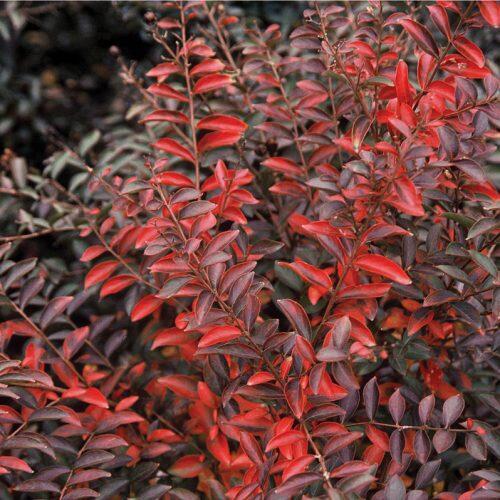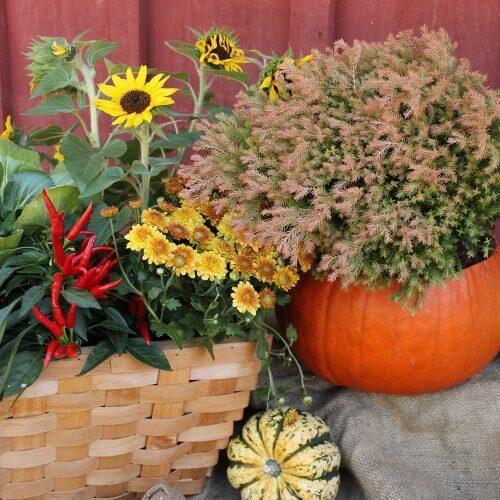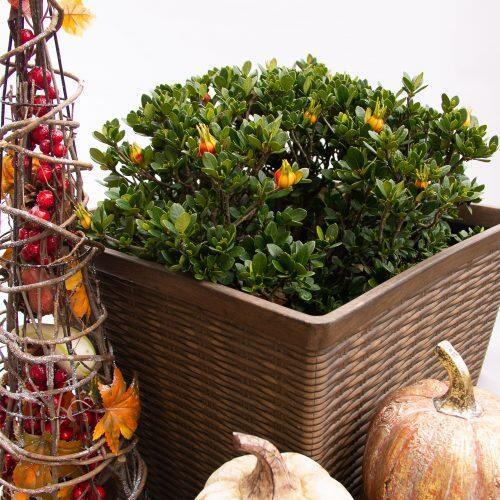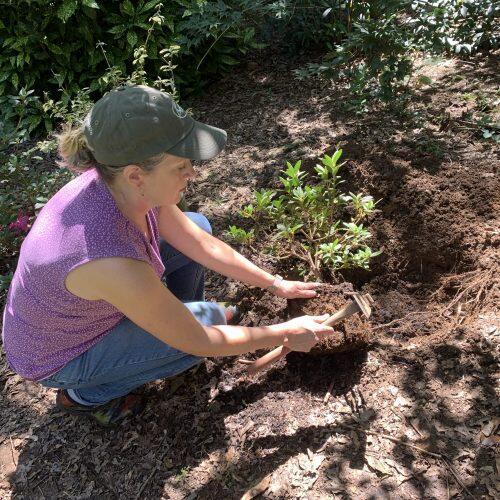Shrubs are some of the most reliable and hardworking plants in the garden.
They are long-lived, big enough to make an impact while still fitting into gardens of any size (even container gardens!), and some offer the same flowers, fragrance, leaf color, or pollinator appeal as your favorite annuals and perennials.
- Most plants are still visible, so you know where you have gaps to fill.
- The year’s successes – and problem spots – are still fresh in your mind, so you know what might need replacing.
- As plants drop leaves, you’ll be able to see where you need some evergreen structure.
- Planting in fall gives your shrubs lots of time to recover and put out new roots before the stress of summer.
- You may be able to take advantage of end-of-season sales at your favorite nursery.
- Cooler weather also makes it more comfortable for you!
Make the most of your planting work by choosing shrubs that look good in more than one season, like evergreens, reblooming shrubs, and plants with pretty fall color.
Some shrubs have fall leaf colors just like trees. Cherry Dazzle dwarf crape myrtle works well in planting and containers.
Many shrubs fit well into containers for dressing up the patio. Bloom ‘N Again reblooming azaleas are perfect for bringing that fall touch.
Evergreens bring year-round color and aren’t always just green. Fire Chief arborvitae has a dusting of red that plays well with autumn arrangements.
Heaven Scent® Gardenia has colorful seed pods of orange, yellow, and red that highlight the lustrous evergreen foliage.
Here’s how to plant your shrubs in the fall for a beautiful garden next year:
- Start with a healthy plant. It’s okay to pull the plant out of its container at the store to make sure the roots are healthy.
- Dig a hole that’s twice as wide but no deeper than your plant’s container. It’s important to plant your new plant at the same level or even slightly higher than the surrounding soil.
- Take your plant out of the container it was sold in.
- Plants bought at the end of the season may have been in their container a long time and be “rootbound” with roots circling around the rootball. Loosen these roots and pull them outward so they can grow out into the soil. It’s even okay to cut them since you are planting in the fall to give them extra time to recover.
- Place your new plant in the center of the hole, checking that the top of the rootball is not lower than the surrounding area.
- Add the soil back into the hole, making sure there aren’t large air pockets. Water well to help settle the soil. Add more soil if needed, but do not pack down after watering – this will compact the soil. Water instead to settle the soil again.
- Spread mulch around your new shrub, keeping the mulch a few inches away from the trunk or stems. Piling mulch against the bark can lead to rot or pest damage. Mulch will help insulate your new shrub’s roots in the winter and keep them cool next summer.
 Use your shovel as a measuring tool! Compare the height of the rootball to your shovel blade to know how deep to dig. Use the handle to get an estimate of how wide to dig – the hole should be twice as wide as the container.
Use your shovel as a measuring tool! Compare the height of the rootball to your shovel blade to know how deep to dig. Use the handle to get an estimate of how wide to dig – the hole should be twice as wide as the container.
It’s important when digging the hole that your new plant should be planted at the same level or even slightly higher than the surrounding soil.
Compare the height of the rootball to your shovel blade to know how deep to dig. Use the handle to get an estimate of how wide to dig – the hole should be twice as wide as the container.
Plants may be “rootbound” with roots circling around the rootball. Loosen these roots and pull them outward so they can grow out into the soil.
Add the soil back into the hole, making sure there aren’t large air pockets. Water well to help settle the soil. Add more soil if needed, but do not pack down after watering – this will compact the soil.
Remember to Water…
![]() How much water is enough? Water just until you see puddles that don’t soak into the ground right away. Do this at least twice a week during the fall and start again the next spring. After the first year, your shrub should be established enough to water on your normal schedule.
How much water is enough? Water just until you see puddles that don’t soak into the ground right away. Do this at least twice a week during the fall and start again the next spring. After the first year, your shrub should be established enough to water on your normal schedule.










